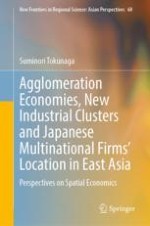This book shows that agglomeration economies, new industrial clusters, and Japanese multinational firms’ location are particularly important for the Japanese manufacturing industry in Japan and East Asia. For that industry, the author first estimated the flexible translog production function using four-digit SIC industry panel data and panel data of the indices of Ellison and Glaeser (1997) agglomeration with the same industry and coagglomeration with different industry groups for 1985–2000. From the estimated results, it was found that there are positive impacts of agglomeration economies on production, especially the externality coagglomeration effect and very slight increasing returns to scale in the Japanese manufacturing industry. Next, the estimation of the location for Japanese industry foreign direct investment (FDI) for 1986–2009 in East Asia using the new economic geography (NEG) model was shown. From these results of estimation of location factors, it was found that the agglomeration economies, market potential and supplier access are particularly important in the location choice of the Japanese manufacturing industry in East Asia. Finally, as Japan’s overall population has been declining since around 2010, the author was to build new industry clusters with digital technologies and elucidate their economic effects to overcome the negative economic impact of declining population and the COVID-19 pandemic using a dynamic four-region computable general equilibrium (D4SCGE) model. The innovation is promoted by these horizontal and vertical agglomerations, and construction of a production pyramid with an efficient production linkage—that is, the construction of new, efficient industrial clusters—is an important policy issue.
